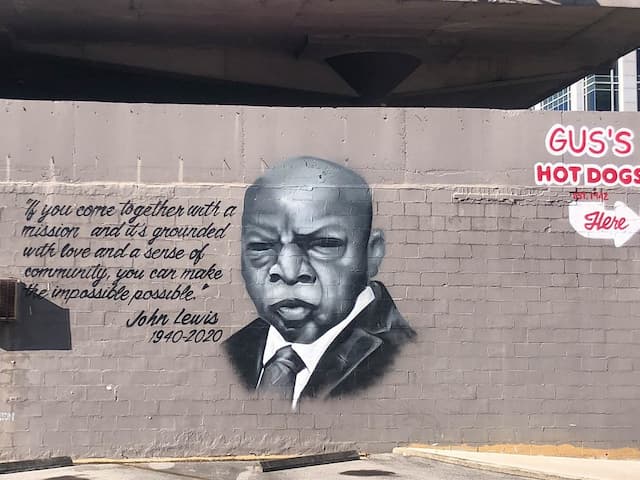
Samford University Howard College of Arts and Sciences students have had their research and writing skills strengthened thanks to Biblical and Religious Studies professor David Bains's Magic City Religion project. For five years, students have completed and published research papers on religious life in Birmingham, Alabama.
"By sharing their findings, we hope to advance the public understanding of religions' roles in our common life," Bains said. "Writing for a public audience motivates students to excel in their research and think deliberately about their writing and the audience they hope to reach."
Last fall, students in Bains’s core seminar class were tasked with writing about a mural depicting a notable religious leader.
"I provided students with a curated collection of photographs of over 40 murals on public display in Birmingham that would be good for them to write on," Bains said. "I included only figures who had been the subject of substantial scholarly study."
Freshman Caroline Goss said, "I was immediately drawn to John Lewis because he was a religious leader who greatly impacted the civil rights movement. Since elementary school, I have always been interested in the civil rights movement and deeply respect the people who led it."
Goss, a communication science and disorders major, chose to write about the John Lewis Mural on Gus's Hot Dogs in downtown Birmingham. Artist Dewon Moton painted it in 2020 following the murder of George Floyd, who was killed by Minneapolis police during an arrest for allegedly using a counterfeit $20 bill.
"I learned a lot about his involvement, specifically in Alabama working with Martin Luther King Jr.," she said. "Together, they fought for the belief in a 'Beloved Community.' Lewis approached the civil rights movement with a Christian approach, which is something I deeply admire."
"The projects students work on require them to research real-world objects, communities and events to discern what is most important about them and to communicate that in an engaging way," Bains said. "Projects for other classes have also required them to get out of their comfort zone and get to know local people in Birmingham."
Finding information on Lewis was challenging for Goss.
"While John Lewis is a well-known civil rights leader, he is not as well-known as Martin Luther King Jr.," she said. "Finding resources for his life and work was a little bit more difficult."
In the end, it all came together. Goss finished her paper and gained a deeper appreciation for Lewis and the civil rights movement.
"I thoroughly enjoyed deepening my knowledge about John Lewis," Goss said. "I felt as if I could learn a lot from his teachings. His selflessness and willingness to suffer for what he believed was good is something I strive to do. In the face of violence and heartache, John Lewis remained faithful to His sovereign plan."
This experience revealed topics Goss loves to write about, but it also exposed her to the world of web writing. Bains believes students who participate become better writers.
He said, "When employers learn I am a professor in the humanities, the most frequent thing they say to me is, 'I hope your students are learning to write.’ They say they are frequently shocked at the mediocre writing skills of the people they hire. The skill employers in many professions desire most is the ability to write clearly, persuasively, logically and efficiently.”
Magic City Religion was inspired by other universities' sites on local religion and a course Bains took in college. In 2021, he published an essay on the project in Fides et Historia, the journal of the Council on Faith and History so that other faculty members can learn from his work.
Having noticed his contributions, Bains was honored with the Howard College of Arts and Sciences Outstanding Teaching Award in spring 2024 by his peers. They described him as a good citizen with a generous spirit who consistently reworks course lectures and assignments to enhance the student experience.
“Running the project for several years has enabled me to craft projects for six different courses,” Bains said. “This has empowered students to explore different aspects of Birmingham’s religious life including images, memorials and worship services. The focus in some courses on the congregations located in neighborhoods, such as Avondale and Woodlawn, has been particularly rewarding. I look forward to students working on the East Lake neighborhood in the Race, Ethnicity and Religion course in fall 2024.”
Magic City Religion is now older and more expansive than any of the projects that inspired it. According to Bains, more than 100 students in 10 classes have produced essays on artworks, religious communities and worship services in and around Birmingham.
Past student research papers can be found on magiccityreligion.org.
